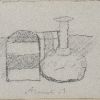The Collection
A praiseworthy contribution: 34 works by Morandi restored thanks to the Istituto Beni Culturali of the Emilia-Romagna Region

The Museo Morandi possesses more than half of the artist’s entire corpus of prints, and it can also boast a significant number of drawings executed from 1907 to 1964, the year of Morandi’s death. All of these sheets, except for a very few exceptions (those bought by the Comune di Bologna, etc.) are the results of the extraordinary donation from Maria Teresa Morandi, the artist’s last sister, to the Comune di Bologna following the foundation of the Museo Morandi, and of the bequest she made, which saw the museum acquire a further 26 drawings. From that moment, these works became part of the comune’s cultural heritage and the museum became responsible for promoting them via their public display, but above all for their conservation, assuring their survival in the future. Thanks to the contribution from the Istituto Beni Culturali, it has been possible to consign a small nucleus of these drawings (28) and etchings (6) into the expert hands of restorer Mariella Gnani, which all require minor restoration and mounting to assure their conservation. This group of works includes an almost unexpected series of portraits and even some anatomical details: a pair of hands, for example; and the faces of his sisters, of his friend Giuseppe Raimondi, and his father Torquato. But above all, there are some Still lifes – a dozen – produced by Morandi between 1923 and 1953, and five Landscapes of Grizzana that date from later, between 1960 and 1962. Critics of recognised competence have written about these and other drawings, executed with a deliberately wavering and tremulous hand: from Raimondi to Brandi, Valsecchi to Argan. So we have no words to add about these works here. But the task does remain to note how these works are sometimes close, sometimes far from what Morandi was painting on canvas at the same time. Using his pencil, the artist created finished and even carefully detailed compositions, but at times some contours are deliberately omitted as Morandi left it to light to define them. If we observe them one by one, we discover how he divided the verticality of a sheet one by one and, for the purposes of study, delineated three variants of the same still life or, using ink, would rapidly sketch out a composition that has nothing in common with the careful and measured lines of the etchings of the same period. A series of six prints that used to hang in Morandi’s studio and were particularly significant for him, show greater signs of the passage of time and continuous exposure to light. On the other hand, the portrait of his sister Maria Teresa, of which he made an etching in 1928, must have failed to satisfy him completely, as only a few copies were printed: one single numbered print and two artist’s proofs. The sheet that originally belonged to Maria Teresa herself had been deliberately torn, confirming the fact that Morandi rejected this series, as wrote Lamberto Vitali in the introduction to his book about Morandi’s drawings and prints.






